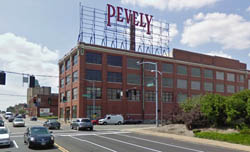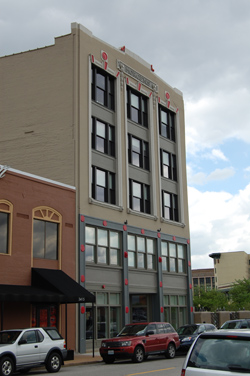Sustainable SLU? The Proposed Demolition of Pevely
On Thursday, November 3rd it was reported by various news outlets that St. Louis University (SLU) applied for demolition permits to raze the historic Pevely Dairy Complex for new construction. Located at 1001 South Grand, the iconic building was constructed in 1915 to house the headquarters of Pevely Dairy Company. The building remained the headquarters for Pevely until it was vacated on October 31st, 2008. Of the more than 130 workers at the dairy, roughly 20 were transferred to a plant in Hazelwood. The following year after it closed, the complex was placed on the National Register of Historic Places while still under the ownership of Prairie Farms, the parent company of Pevely Dairy. For the past three years the complex has sat vacant.
 |
| Pevely Dairy courtesy of RFT |
Two months ago Landmarks obtained a copy of the September 2011 message from the President of St. Louis University, Fr. Lawrence Biondi. In his message to faculty, staff and students, Biondi noted several property acquisitions made by the university which included the former Pevely headquarters. Without any indication of the intentions of the university concerning the old dairy plant, the future of the complex hung in the balance. However, many remained hopeful that SLU would continue is recent trend of successful adaptive re-uses such as Hotel Ignacio and Il Monastero , with Pevely.
The hope for adaptive re-use was emboldened by SLU's embrace of the sustainability movement through its establishment of the Center for Sustainability in April 2010. SLU also initiated an interdisciplinary master's degree in sustainability, which the university touts as the first of its kind in the Midwest. SLU further committed itself to advancing sustainability by drafting a "Sustainability Handbook." The purpose of the handbook is to create,
"A framework and set of guidelines that will enable SLU to develop, renovate, and maintain its campus in a sustainable manner and to identify initiatives to promote sustainability awareness within the university, local community, and throughout the region."
Dr. Timothy Keane, director of SLU's Center for Sustainability reiterated the university's commitment to sustainability stating,
"Sustainability can be interpreted in many ways, but when you consider it from an ethics perspective, most recognize there is an urgent need to change from the irresponsible consumption and unbridled development of the past."
SLU has recognized this "urgent need" by implementing several innovative programs. These forward thinking steps include purchasing items from 16 local farms, constructing LEED certified campus buildings, managing rainwater and much more. With regard to adaptive re-use of historic structures, the university has made great strides. One example is the recent rehabilitation of the 106 year old Morgens Building into the 51 room Hotel Ignacio. The project created roughly 103 construction jobs, 125 permanent jobs and generated an estimated $315,500 in local and $403,400 in state taxes. In 2005 SLU purchased the former Catholic Hospital Association building at 1438 S. Grand constructed in 1953. Currently known as Monteleone Hall, the historic building now houses SLU's Department of Neurology and Psychiatry. The university also purchased the 82 year old Berea Presbyterian Church at 3010 Olive Street and adaptively reused it as an events space currently known as Il Monastero. These are just three of ten existing buildings in St. Louis' built environment that SLU has recently purchased and retrofitted for modern purposes. So why not Pevely? The highly visible Pevely Dairy complex could be another feather in the SLU's cap for its noteworthy and progressive sustainability efforts. Slated for demolition to construct a new medical facility, Pevely could be repurposed to satisfy the need of the university. Examples of similar adaptive re-uses of historic buildings for medical purposes can be found throughout the nation.
 |
| Hotel Igancio formerly the Morgens Building |
In contrast, the demolition of Pevely would counteract SLU's goals of sustainability by releasing the "embodied energy" contained within the building. The term embodied energy relates to the amount of energy expended in the creation and construction of a building. For example, the bricks of Pevely contain a large amount of embodied energy. The clay used to create the brick was mined using a bevy of miners to extract the material. Once mined, the clay was loaded onto trucks and transported to a brick manufacturer. At the manufacturer, the clay was molded then, hydraulically pressed and fired in large kilns. The finished brick was again loaded on trucks and transported to the site where the complex now sits. The brick was laid in place by a handful of masons and bricklayers to create the walls of Pevely. Each step of this process required a large amount fossil fuels, cash, and manpower that are now "contained" within the brick. A similar amount of energy/resources was also needed for the windows, plaster, metal and other elements used in the creation of the complex. Demolishing the buildings would require a similar, if not greater, expenditure of energy to construct a new building and would increase the university's carbon foot print on the environment.
The amount of waste created by Pevely would be astounding. According to Richard Moe, former president of the National Trust for Historic Preservation, "Demolishing a 50,000 square foot building creates 4,000 tons of waste, enough to fill 26 box cars - a train one-quarter mile long." Additionally, "Constructing a new 50,000 square foot building releases as much carbon as driving a car 2.8 million miles."
Hopefully SLU will continue its commitment towards sustainability and adaptively re-use the Pevely Dairy Company buildings. We have already lost several historic structures and entire neighborhoods for the expansion of the school.
If you would like to voice your opinion regarding the proposed demolition of Pevely contact Jospeh Roddy, alderman of the 17th Ward (where the complex is located). You can also contact the President of St. Louis University, Lawrence Biondi. Also, contact Mayor Slay and let him know how you feel. Let's work together and keep this historic complex, which is a viable and necessary element of St. Louis' built environment.
